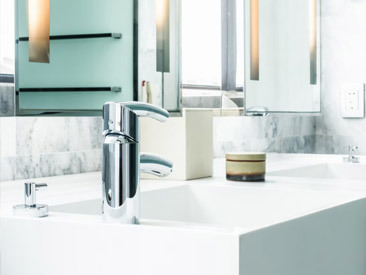Transform Your Kitchen: Choosing the Perfect Sink for Style and Functionality
2024-08-05
Author:
Transform Your Kitchen: Choosing the Perfect Sink for Style and Functionality Table of Contents 1. Introduction: The Importance of a Kitchen Sink 2. Types of Kitchen Sinks: Finding Your Fit 2.1 Single Basin Sinks 2.2 Double Basin Sinks 2.3 Farmhouse Sinks 2.4 Undermount Sinks 2.5 Drop-In Sinks 3. Materials Matter: Choosing the Right Sink Material

Transform Your Kitchen: Choosing the Perfect Sink for Style and Functionality
Table of Contents
- 1. Introduction: The Importance of a Kitchen Sink
- 2. Types of Kitchen Sinks: Finding Your Fit
- 2.1 Single Basin Sinks
- 2.2 Double Basin Sinks
- 2.3 Farmhouse Sinks
- 2.4 Undermount Sinks
- 2.5 Drop-In Sinks
- 3. Materials Matter: Choosing the Right Sink Material
- 4. Size and Depth: Finding the Perfect Fit for Your Space
- 5. Essential Features to Consider When Choosing a Sink
- 6. Installation Guidelines: DIY or Professional Help?
- 7. Maintenance Tips for Your Kitchen Sink
- 8. Conclusion: Elevate Your Kitchen with the Right Sink
- 9. FAQs: Your Sink Questions Answered
1. Introduction: The Importance of a Kitchen Sink
Choosing the perfect sink is a significant step in transforming your kitchen into a functional and stylish space. As one of the most utilized elements in the kitchen, the sink plays a vital role in daily activities, from washing dishes to food preparation. Therefore, it is essential to consider various factors before making a decision.
In this guide, we will explore the different types of sinks, materials available, essential features, installation procedures, and maintenance tips, empowering you to make an informed choice that meets your aesthetic preferences and functional needs.
2. Types of Kitchen Sinks: Finding Your Fit
When selecting a sink, the first step is to determine which type suits your kitchen layout and personal style. Below are some popular sink types to consider.
2.1 Single Basin Sinks
Single basin sinks are ideal for those who prioritize a spacious area for washing large pots and pans. With no divider in the middle, these sinks provide ample room, making them a favorite among home chefs. Available in various styles and materials, they easily integrate into any kitchen design.
2.2 Double Basin Sinks
Double basin sinks offer the practicality of multitasking. The two compartments allow for separating washing and rinsing, enhancing efficiency in the kitchen. They come in various configurations, such as equal-sized basins or one larger basin with a smaller one, catering to different cooking habits.
2.3 Farmhouse Sinks
Farmhouse sinks, also known as apron sinks, add a rustic charm to any kitchen. Their deep, front-facing design makes them both stylish and functional, ideal for filling large pots and managing kitchen tasks with ease. These sinks come in various materials, including cast iron and fireclay.
2.4 Undermount Sinks
Undermount sinks are installed beneath the countertop, creating a seamless look. This style is perfect for those who appreciate a clean, modern aesthetic while enjoying the practical benefits of easy cleanup. They work particularly well with solid surface countertops like granite or quartz.
2.5 Drop-In Sinks
Drop-in sinks are designed for easy installation and are a popular choice for DIY enthusiasts. With a rim that rests on the countertop, they come in a variety of styles and sizes, making them versatile for different kitchen designs. This type provides an easy upgrade for those looking to refresh their space without a complete remodel.
3. Materials Matter: Choosing the Right Sink Material
The material of your kitchen sink impacts both its durability and aesthetic appeal. Here's a breakdown of some of the most common sink materials.
3.1 Stainless Steel
Stainless steel sinks are favored for their durability, resistance to stains, and easy maintenance. They blend well with modern kitchen designs and come in various finishes, such as brushed or polished. Their resilience against heat and impact makes them an excellent choice for busy kitchens.
3.2 Ceramic
Ceramic sinks offer a classic, timeless look. Available in various colors and finishes, they can complement any kitchen style. While they are generally easy to clean, they can be prone to chipping, so careful handling is necessary.
3.3 Composite
Composite sinks, made from a blend of materials such as acrylic and granite, provide a durable and stylish option. They are resistant to scratches and stains, making them ideal for busy kitchens. Moreover, they come in various colors and textures, allowing for personalization.
3.4 Cast Iron
Cast iron sinks, often coated with enamel, provide both durability and a classic look. These heavy sinks can withstand heavy use and add a touch of elegance to any kitchen. However, they require regular maintenance to keep the enamel from chipping or discoloring.
3.5 Custom Sinks
For those seeking a unique design, custom sinks offer endless possibilities. Tailored to your specifications, these sinks can be made from various materials and shapes, ensuring a perfect fit for your kitchen layout and personal style.
4. Size and Depth: Finding the Perfect Fit for Your Space
Before purchasing a sink, measuring your available space is crucial. Kitchen sinks come in various sizes and depths, so it's essential to consider your kitchen layout and how you intend to use the sink. A deeper sink can be beneficial for washing larger items, whereas a shallower sink may suffice for smaller kitchens.
Additionally, ensure that the sink size complements your countertop and cabinetry to maintain a cohesive look in your kitchen design.
5. Essential Features to Consider When Choosing a Sink
Beyond the type and material, several features can enhance your kitchen sink experience. Below are some essential features to consider.
5.1 Sink Accessories
Accessories such as cutting boards, colanders, and sink mats can make washing and food prep more efficient. Some sinks come with built-in accessories that can be a great space-saving solution, ensuring a tidy kitchen environment.
5.2 Faucet Options
Choosing the right faucet is just as important as selecting the sink itself. Consider the height and reach of the faucet, as well as the type of spray options it offers. Touchless faucets are becoming increasingly popular for their convenience and hygiene benefits.
6. Installation Guidelines: DIY or Professional Help?
Installing a kitchen sink can be a straightforward DIY project, but it’s essential to assess your skills and comfort level. If you’re inexperienced, hiring a professional plumber can ensure that the sink is installed correctly, preventing future issues.
When opting for a DIY installation, follow the manufacturer’s instructions closely and take all necessary precautions to avoid plumbing mishaps.
7. Maintenance Tips for Your Kitchen Sink
Regular maintenance is key to prolonging the life of your kitchen sink and keeping it looking great. Here are some maintenance tips:
1. **Clean Regularly**: Use a mild detergent and warm water to clean your sink. Avoid harsh chemicals that can damage the finish.
2. **Avoid Excessive Heat**: Protect your sink from extreme temperatures by not placing hot pots directly in the sink.
3. **Rinse After Use**: Rinsing your sink after each use can prevent stains and buildup.
4. **Check for Leaks**: Regularly inspect plumbing connections for leaks to avoid water damage.
8. Conclusion: Elevate Your Kitchen with the Right Sink
Choosing the perfect sink is a crucial step in the kitchen transformation process. By understanding the various types of sinks, materials, features, and maintenance requirements, homeowners can make an informed decision that enhances both the functionality and style of their kitchen. Take the time to consider your needs and preferences, and soon you’ll find a sink that becomes the heart of your kitchen—a space where family and friends gather to create lasting memories.
9. FAQs: Your Sink Questions Answered
1. What size sink should I choose for my kitchen?
The size of your sink depends on your kitchen layout and how you use it. Measure your space and consider your daily tasks to determine the best size.
2. Are farmhouse sinks practical?
Yes, farmhouse sinks are both stylish and practical. Their deep design makes them ideal for washing large pots and pans, but they do require careful consideration for installation.
3. How do I clean my stainless steel sink?
To clean a stainless steel sink, use warm soapy water and a soft cloth. Avoid abrasive cleaners that can scratch the surface.
4. Can I install a sink myself?
If you are comfortable with plumbing and DIY projects, you can install a sink yourself. However, hiring a professional is advisable if you're unsure.
5. What is the difference between undermount and drop-in sinks?
Undermount sinks are installed beneath the countertop, creating a seamless look, while drop-in sinks have a rim that rests on the countertop, making them easier to install.
With this comprehensive guide to choosing the perfect kitchen sink, you can confidently make a decision that enhances your kitchen’s beauty and functionality. Happy transforming!









